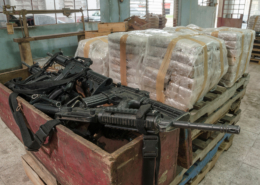Blockchain & Ballistics
The Crypto Trade Connecting the Houthis, Iran, and Russia
📅 July 25, 2025
📅 July 25, 2025
The Houthis, Iran’s most active remaining proxy, have entered a new frontier of warfare: using cryptocurrency to purchase advanced weapons systems. Not only are terrorist financing and digital asset adoption converging, but terrorist organizations are increasingly collaborating with jurisdictional partners to circumvent the global financial system and acquire advanced weaponry.
The Houthis have raised potentially billions of dollars as a direct participant in Iran’s oil smuggling schemes and shadow banking operations. The mastermind behind the Houthis’ financial and commercial networks, Sa’id al-Jamal, is embedded within the Iranian Revolutionary Guards Corps (IRGC) and has cultivated his own global networks to facilitate the illicit sale of Iranian oil, with comparable typologies to those of the IRGC. Shipping services, port managers, front companies for oil trading, import-export and logistics companies, and other businesses, are directly controlled by the Houthis and support all aspects of the supply chain.
Similar to Iran’s shadow banking schemes, al-Jamal has co-opted existing exchange houses or established his own – in Yemen and elsewhere – to store and launder the majority of proceeds of oil smuggling operations. The exchange houses allow the Houthis to both funnel the proceeds of the illicit oil trade back to Yemen and access funds abroad. Like other terrorist organizations, the Houthis also use digital assets to launder their illicitly sourced revenue and at times as a means of conversion to local fiat currency. However, the Houthis’ pivot towards digital assets as a form of settlement is emblematic of remarkable shifts in the geopolitical environment and fissures in the global financial architecture.
What is the Axis of Resistance?
The Axis of Resistance is a loose network of terrorist organizations supported by Iran, including the Houthis, Hamas, Lebanese Hezbollah, Palestinian Islamic Jihad, various militias in Iraq, and formerly the Assad regime in Syria. Although not all groups are uniform politically and ideologically, they have collaborated substantially in facilitating cross-border financial flows to each other, aided by Iranian expertise. The Houthis are arguably Iran’s strongest remaining partner in the Axis of Resistance.
The incorporation of digital assets into the toolkit of terrorist organizations, both within and outside the Axis of Resistance, is not a novel development. Hamas, Hezbollah, the Islamic State Khorasan Province, and others solicit donations from sympathizers in the form of cryptocurrencies, broadcasting their donation drives on encrypted messaging platforms such as Telegram. In addition to fundraising, some groups, including the Houthis, have begun mining decentralized digital assets without the need for specialized hardware infrastructure.
Terrorist organizations are beginning to prefer stablecoins such as Tether over more volatile assets such as Bitcoin. Hamas, Palestinian Islamic Jihad, and Hezbollah have sent funds between each other using the same virtual asset service providers (VASPs) in an effort to cooperate and convert stablecoins to fiat currencies.
Terrorist groups often exploit underground exchanges without adequate KYC measures to host their wallets.
The Houthis’ digital asset operations flow between counterparties on unlicensed exchanges, with similar typologies to traditional finance money laundering.
On April 2, 2025, the U.S. Treasury Department sanctioned eight wallets associated with the Houthis. An analysis of the wallets conducted by blockchain analysis firm TRM Labs linked Houthi-controlled wallet addresses to a “Russian broker selling unmanned aerial vehicles (UAVs) and anti-UAV equipment” on the Garantex exchange. No longer are digital assets solely adopted by terrorist groups as vehicles for money laundering. Now, they are being used as a medium of exchange in weapons dealings.
OFAC’s discovery and TRM’s analysis of Houthi wallets point to a concerning development and potentially dangerous trend. The Houthis are not working in a vacuum, and Iran’s diffusion of expertise extends beyond oil smuggling and shadow banking. The international partners of the Houthis – Iran and Russia – are cooperating to reshape global financial infrastructure, and entities domiciled in both jurisdictions are facilitating the provision of UAVs and other weaponry to the Houthis.
The Accelerating Use of Crypto by Sanctioned States
The rate at which comprehensively sanctioned states have begun to use digital assets as a transaction medium has accelerated in recent years. The Iranian regime and especially the IRGC, the Houthis’ main backer, has long sought to evade sanctions through cryptocurrencies. In 2024, Russia integrated digital assets into its cross-border payment systems to ease the bite of sanctions, and after being blocked from accessing Tether, has endeavored to create a new token as a workaround. The two nations have also previously explored the possibility of creating a common stablecoin to facilitate trade between them.
There are currently no indications that the Houthis will transition to mostly using crypto for weapons payments in the foreseeable future. However, as digital asset infrastructure proliferates globally and sanctioned jurisdictions work to find alternatives to the financial systems they have been cut off from, financial crime risk for VASPs and crypto-related businesses will continue to increase.
Despite the use of methods to obfuscate transactions and avoid detection, such as mixers and tumblers, and the use of unlicensed exchanges, both VASPs and traditional financial institutions can interdict the flow of illicit cryptocurrency. For example, the Houthis utilized mainstream exchanges to offramp crypto into fiat currency.
Traditional due diligence methods and screening tools can reveal common money laundering typologies, while blockchain analytics tools enable detection of suspicious transactions between wallets. Some well-established AML typologies have digital asset equivalents or apply equally in the crypto context, including:
The Houthis’ evolving use of digital assets to procure advanced weaponry marks a dangerous escalation in terrorist financing tactics. As sanctioned states and terrorist groups exploit digital assets to bypass global controls, the convergence of crypto and illicit networks demands urgent, coordinated action. Financial institutions, including crypto businesses, must adapt swiftly to detect and disrupt these sophisticated schemes to safeguard the integrity of the global financial system.










 July 2025 Sanctions and Export Controls Update
July 2025 Sanctions and Export Controls UpdateThis site uses cookies. By continuing to browse the site, you are agreeing to our use of cookies.
Accept settingsHide notification onlySettingsWe may request cookies to be set on your device. We use cookies to let us know when you visit our websites, how you interact with us, to enrich your user experience, and to customize your relationship with our website.
Click on the different category headings to find out more. You can also change some of your preferences. Note that blocking some types of cookies may impact your experience on our websites and the services we are able to offer.
These cookies are strictly necessary to provide you with services available through our website and to use some of its features.
Because these cookies are strictly necessary to deliver the website, refusing them will have impact how our site functions. You always can block or delete cookies by changing your browser settings and force blocking all cookies on this website. But this will always prompt you to accept/refuse cookies when revisiting our site.
We fully respect if you want to refuse cookies but to avoid asking you again and again kindly allow us to store a cookie for that. You are free to opt out any time or opt in for other cookies to get a better experience. If you refuse cookies we will remove all set cookies in our domain.
We provide you with a list of stored cookies on your computer in our domain so you can check what we stored. Due to security reasons we are not able to show or modify cookies from other domains. You can check these in your browser security settings.
These cookies collect information that is used either in aggregate form to help us understand how our website is being used or how effective our marketing campaigns are, or to help us customize our website and application for you in order to enhance your experience.
If you do not want that we track your visit to our site you can disable tracking in your browser here:
We also use different external services like Google Webfonts, Google Maps, and external Video providers. Since these providers may collect personal data like your IP address we allow you to block them here. Please be aware that this might heavily reduce the functionality and appearance of our site. Changes will take effect once you reload the page.
Google Webfont Settings:
Google Map Settings:
Google reCaptcha Settings:
Vimeo and Youtube video embeds:
You can read about our cookies and privacy settings in detail on our Privacy Policy Page.
Privacy Policy